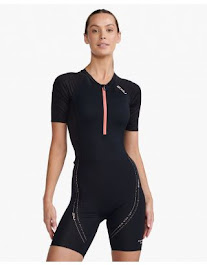The Pros and Cons of Different Swimming Wetsuit Materials
Swimming wetsuits are required equipment for open-water swimmers, triathletes, and surfers. They help you swim faster and farther by keeping you warm, reducing drag, and increasing buoyancy. Wetsuits are made from a variety of materials, each with its own set of pros and limitations. In this blog post, we'll go over the benefits and drawbacks of various wetsuit fabrics.
Neoprene Wetsuits
Neoprene is the most commonly used material for swimming wetsuits. It's a synthetic rubber that's durable, flexible, and insulating. Neoprene wetsuits come in different thicknesses, ranging from 1mm to 7mm. The thicker the wetsuit, the more insulation it provides.
Pros:
Flexibility: Neoprene wetsuits are very flexible, which allows for a full range of motion in the water. You can move your arms and legs freely, which is essential for swimming efficiently.
Insulation: Neoprene wetsuits provide excellent insulation, keeping your body warm in cold water. This is particularly important for open water swimmers who spend extended periods in the water.
Durability: Neoprene wetsuits are very durable and can withstand wear and tear from regular use. They're resistant to punctures and abrasions, ensuring they last for several seasons.
Cons:
Weight: Neoprene wetsuits are relatively heavy, which can make them feel cumbersome and tiring to wear. This can be a disadvantage for swimmers who prefer a lighter and more streamlined feel in the water.
Buoyancy: While neoprene wetsuits provide excellent insulation, they also increase buoyancy. This can make it harder to maintain a horizontal swimming position, especially for swimmers who already have a high body fat percentage.
Limestone Neoprene Wetsuits
Limestone neoprene is a variation of traditional neoprene that's made using calcium carbonate from limestone instead of petroleum. It's a more sustainable and eco-friendly alternative to traditional neoprene.
Pros:
Sustainability: Limestone neoprene is a more sustainable and eco-friendly option than traditional neoprene. It's made using a renewable resource and requires less energy to produce.
Flexibility: Limestone neoprene swimming wetsuits are very flexible and provide a full range of motion in the water. This is essential for efficient swimming.
Durability: Limestone neoprene wetsuits are durable and can withstand wear and tear from regular use.
Cons:
Price: Limestone neoprene wetsuits are more expensive than traditional neoprene wetsuits. This can be a disadvantage for swimmers on a budget.
Insulation: While limestone neoprene wetsuits provide good insulation, they may not be as warm as traditional neoprene wetsuits.
Hydrophobic Wetsuits:
Hydrophobic wetsuits are made from materials that repel water, such as silicone-coated neoprene or polyurethane. These swimming wetsuits are designed to reduce drag and increase speed in the water.
Pros:
Speed: Hydrophobic wetsuits reduce drag, which can increase speed in the water. This is particularly beneficial for competitive swimmers who want to improve their performance.
Lightweight: Hydrophobic wetsuits are typically lighter than traditional neoprene wetsuits, which can provide a more streamlined feel in the water.
Cons:
Cost: Hydrophobic wetsuits are generally more expensive than traditional neoprene wetsuits, which can be a disadvantage for swimmers on a budget.
Flexibility: Hydrophobic wetsuits are typically thicker and stiffer than traditional wetsuits, which can limit flexibility and range of motion.
Usage: Hydrophobic wetsuits are designed specifically for water sports such as surfing, diving, and swimming, so they may not be suitable for other outdoor activities or general use.
In conclusion, choosing the right wetsuit material for swimming depends on various factors such as budget, water temperature, and personal preferences. Ultimately, it's essential to prioritize comfort and safety when selecting a wetsuit material that suits your needs.
Buy the finest materials swimming wetsuit womens from Trishack and go enjoy the tides today!




Comments
Post a Comment